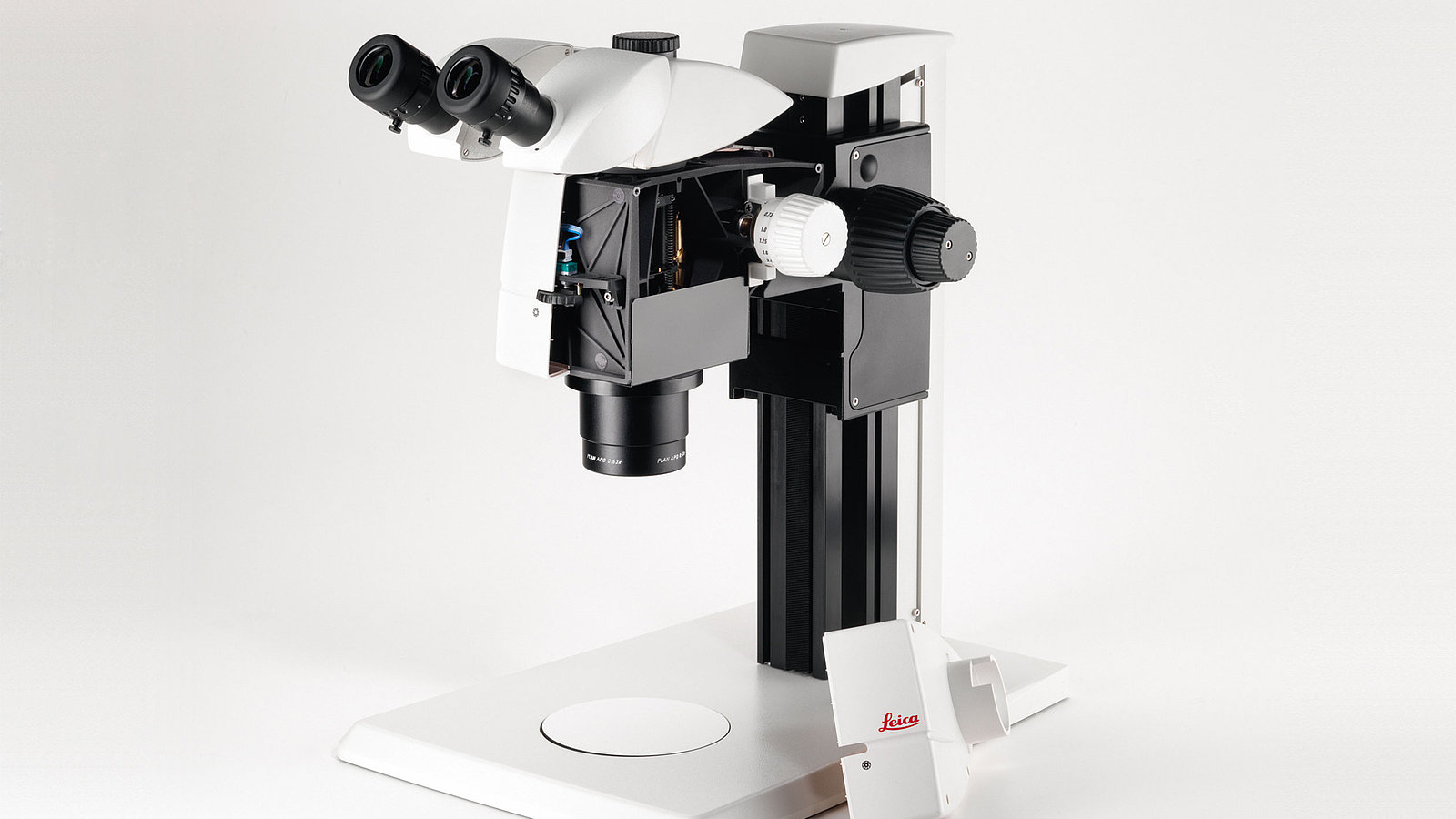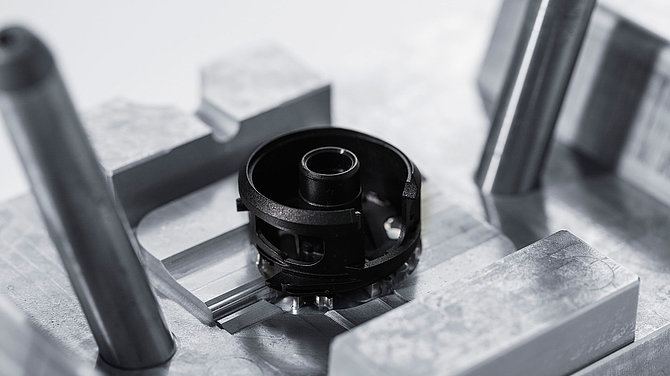In the small, tranquil village of Heerbrugg (Canton St. Gallen), Leica Microsystems develops internationally renowned stereomicroscopes and macroscopes. The name Leica carries a lot of water. In the 19th century, the company's founder, Ernst Leitz, focused on designing microscopes that perfectly fulfilled his customers' specific requirements. As Andreas Bosch cheerfully leads us into the Leica showroom, he casually points to an elegant stereomicroscope from the company's M series and says, quite modestly, that it is the best stereomicroscope in the world. He then gives us some insights into his work.
Mr Bosch, how did you become a development engineer? What fascinates you about high-end precision optical systems?
It's always the attraction of doing something new. I originally come from a manufacturing background. I studied mechanical engineering and worked for manufacturing companies before I joined the development department at Leica. Development means something new happens every day, you're always doing new things, in production engineering you're at the edge of what is feasible and constantly trying to find new possibilities, solutions to new problems. That's the appeal for me. I've been in this division at Leica for six years.
What role does a functional prototype play in the development of high-precision stereomicroscopes?
A good prototype is a decisive factor. On the one hand, it serves to verify the concept, it allows you assess whether what you have in mind works at all, whether the parts work as they should and as intended. A prototype is therefore firstly a test bench for the technology and, secondly, we also take the prototypes to
„Without prototypes, there are no new products.“
key customers worldwide and show them the sample, and again verify the concept for the whole project – can we bring it to market like this, can we sell it? Or are there things we need to improve, are we on the right or the wrong track? Without prototypes there are no new products! The journey always involves a prototype.
Can you describe the collaboration between Leica and 1zu1 Prototypes using the example of the M-series stereomicroscope?
Yes. So, working with 1zu1 is appealing to us because of their speed, but also their honesty. If 1zu1 sees a problem with the production of the requested prototype, they come to us and tell us that, in this or that area, we need to try a new solution. This also includes the top consulting service that 1zu1 offers me. With new projects, I simply have the feeling that the consultations help me make the right technical decisions: What would be better as a casting? Should we use STL for the plastic parts? There are simply many things to weigh up. And if we need functional models, they take care of it quickly and efficiently.
How did you feel about the special functional prototype that you needed for the M series? In terms of function, accuracy, design, surface finish? Were you satisfied with 1zu1?
Yes, so especially with this project the challenge was the amount of different parts we needed, and I was initially worried about getting everything we needed, but it all worked out very well. Excellent quality, the exact level of precision we needed, and the usual fast turnaround. So I have to say, we're very pleased.
Which parts did 1zu1 manufacture for you?
If we start with the technology, it was actually the die-cast parts (aluminum die-cast parts) and the plastic injection-molded parts. They always come from 1zu1. Taking a closer look at the product, these parts are for the chassis, the plastic parts are the covers and the tube housing. The housing in general needs a lot of work ...
The prototype then goes on a journey. What does that mean?
We follow proven procedures. First, we do our internal tests – we have very demanding and strict internal quality standards that we have to meet and, if the prototype has passed all this successfully, we pack the functional model into our suitcase and fly to our customers. Worldwide: Japan, China, Singapore, USA, Europe, Switzerland, wherever the
„When the prototype is finished and inspected, we put it in our suitcase and take it on a world tour.“
key customers are located, we fly there and show them the prototype, get feedback and, if there are any changes, we incorporate them before we start series production, before we spend the money on expensive tools and before we start series production. At the customer's premises, we use the functional prototype to check whether we've made any mistakes during development, whether we've considered all requirements.
The keyword here is „precision“ – a prototype should be as precise as the original. Does 1zu1 meet your requirements in terms of precision?
Yes, they achieve this. They make precise prototypes.
And does this include the μm (micrometer) range?
Yes, to within thousandths of a millimeter.
Thinner than a human hair, so to speak?
Yes. Ten times thinner than a human hair, roughly speaking. Even with the prototype.
Is that one of the reasons why you chose 1zu1 Prototypes as your development partner?
There was already a long-standing relationship with 1zu1 that existed before I joined Leica. The sum of what 1zu1 can offer is the decisive factor for me. 1zu1 is able to make aluminum castings, but they can also produce plastic parts and, more importantly, they achieve the precision that we require in the subsequent machining process. In my view, the broad spectrum of know-how coupled with speed and precision is actually what makes our partnership so successful.
Why is mechanical finishing so important for you?
Ultimately, only a blank is produced in the casting process. The actual dimensions are only realized via exact machining, which is where precision comes into play. The high-precision prototypes that we take to customers are used to move optical lens components, and they need to be as precise as possible to achieve the kind of quality that our customers expect and rightly demand. The actual value creation therefore takes place in the machining process, whereby the part's appearance and the fineness of the surfaces are important factors.
Through the M-205 we were able to take a look at a tiny chip. Interesting, very plastic, with a 3D effect. What do you most enjoy examining under the microscope?
Each image creates its own fascination. Biological preparations inspire me just as much as delving into materials science or chip production. To see the tiniest wires, as if soldered, that fascinates me as a mechanical engineer. To be able to follow the progress of technology with your own eyes, so to speak, and to make the various qualities visible with the help of our microscopes, that's really something!
Thank you for this interview.
Andreas Bosch is Team Leader Project Management Industry Division at Leica Microsystems Switzerland. The interview was conducted by Hermann Brändle.

![[Translate to English:] Stereolithography (STL/SLA)](/fileadmin/_processed_/a/5/csm_1zu1-STL-Duese-prozess_2ff0afbb81.jpg)
